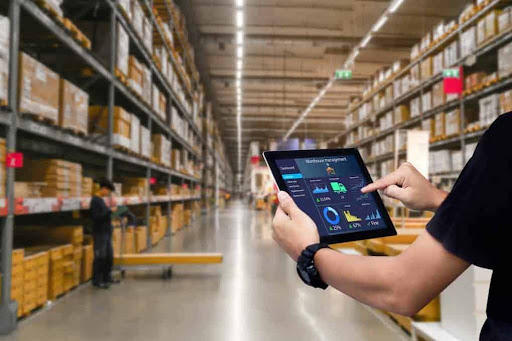Warehouses are essential for businesses that require large spaces for storing and distributing their products. With the increasing demand for faster and more efficient logistics processes, companies need to keep up with the latest innovations. Smart technologies have become a game-changer for warehouses, enabling them to operate more efficiently, productively, and safely.
So, let’s discuss 7 smart warehouse technologies to implement today and how they help businesses improve their operations and stay competitive in the market.
1. Warehouse Management System (WMS)
A Warehouse Management System (WMS) is software that automates and optimizes warehouse operations, including inventory management, order fulfillment, and shipping. It enables warehouses to manage their inventory levels, reduce labor costs, and improve the accuracy of their shipments.
With WMS, managers can monitor the movement of goods and create reports that provide insights into warehouse performance. Also, it facilitates better communication between warehouse staff, which increases productivity and teamwork.
2. Automated Guided Vehicles (AGVs)
Although the need for transport vehicles, like forklifts from MLA Holdings, will never stop, smart technologies can be used to contribute to improved organization of work. Automated Guided Vehicles (AGVs) are self-driving vehicles that move around the warehouse autonomously, transporting items from one location to another.
These vehicles can transport heavy goods, freeing up the workforce to focus on other tasks, and also reducing the risk of injury from manual labor. They are useful in large warehouses with high-volume and high-density storage areas, where human workers may find it difficult to navigate.
3. Pick-to-Light Systems
Pick-to-Light Systems is a technology that guides warehouse workers through the picking process. It uses lights and displays to direct staff to the location of the items they need to pick. It can reduce the time it takes to fulfill orders, improve accuracy, and reduce errors caused by wrong picks.
Pick-to-Light Systems are especially useful in high-volume warehouses where picking accuracy is critical for everything to function properly. Additionally, they can improve productivity, save time, and increase distribution which can in turn bring more profit.

4. Voice Picking Systems
Another smart picking technology is Voice Picking Systems which uses voice commands to guide warehouse workers through the picking process. Warehouse workers wear headsets that provide them with instructions on where to go and what goods to pick.
Workers respond to the system using voice commands, which are then translated into data and sent to the Warehouse Management System. Voice Picking Systems are useful in noisy warehouses or where other picking technologies may be less effective.
5. Wearable technology and AR
Wearable technology, such as smart glasses and smartwatches, can provide warehouse workers with real-time information about inventory, order status, and other crucial data. Such wearables can also provide workers with instructions on how to perform specific tasks and help them locate products more quickly.
Augmented Reality (AR) technology overlays digital information onto the physical world, providing warehouse workers with real-time data and instructions. It can be used to guide workers through the picking process, identify storage locations, and provide information on product specifications. AR can also be used to provide training for new employees, reducing the time it takes to instruct new hires.
6. Internet of Things (IoT)
The Internet of Things (IoT) is a network that builds connections between devices so they can communicate with each other and exchange data over the Internet. For example, sensors can be placed on shelves and pallets to track inventory levels and ensure that items are stored in the correct location. This information can then be transmitted to a central database, allowing workers to quickly locate items and restock shelves.
IoT technology can also be used to monitor environmental conditions such as temperature and humidity, ensuring that goods are stored in optimal conditions. Additionally, IoT sensors can be used to track the movements of workers and vehicles in the warehouse, improving safety and reducing the risk of accidents.
7. Predictive analytics
By analyzing data from various sources, including past performance metrics and real-time sensor data, predictive analytics can help warehouses make informed decisions about inventory management, staffing, and shipping logistics. For instance, predictive analytics can help warehouses anticipate which products are likely to sell quickly and ensure that those products are always in stock.
Additionally, this smart technology can help warehouses optimize their staffing levels by predicting peak periods of demand and adjusting schedules accordingly. With the implementation of predictive analytics, warehouses can operate more efficiently, reduce waste and costs, make more informed decisions, and improve customer service.
The bottom line
The implementation of these 7 smart warehouse technologies has the potential to revolutionize how certain businesses handle storage and distribution. Smart technologies can improve efficiency, reduce operational costs, and bring higher customer satisfaction. These may be just some of the smart solutions that companies can implement today and every business should find the ones that fit best with their needs. However, implementing even one is a good start to help a business stay competitive and meet the demands of the always-changing market.



